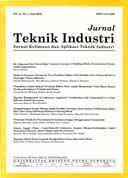Predicting the Readiness of Indonesia Manufacturing Companies toward Industry 4.0
A Machine Learning Approach
DOI:
https://doi.org/10.9744/jti.23.1.1-10Keywords:
Industry 4.0, Clustering, Classification, Decision TreeAbstract
This research discusses Indonesia's readiness to implement industry 4.0. We classified the Indonesia manufacturing companies' readiness, which is listed in the Indonesia Stock Exchange, in industry 4.0 based on the 2018 annual reports. We considered 38 variables from those reports and reduced them using principal component analysis into 11 variables. Using clustering analysis on the reduced dataset, we found three clusters representing the readiness level in implementing industry 4.0. Finally, we used the decision tree for analysing the classification rules. As the finding of this study, Total book value of the machine is the variable that defined the readiness of a company in industry 4.0. The bigger those values are, the more ready a company to compete in industry 4.0. The other measures, i.e., Total cost of revenue by total revenue; Direct labor cost; Total revenue/Total employee and Transportation cost/Total revenue, will define the readiness of a manufacturing company to transform into industry 4.0. or not ready to transform into industry 4.0.
Downloads
References
Luenendonk, M., Industry 4.0: Definition, Design Principles, Challenges, and the Future of Employment, Cleverism, 2019, Retrieved from: https://www.cleverism.com/industry-4-0/
Marr, B., Why Everyone Must Get Ready for the 4th Industrial Revolution, Forbes, 2016.
Moore, M., What is Industry 4.0? Everything You Need to Know, TechRadar 2019.
Indonesia Investment, Widodo Launches Road-map for Industry 4.0: Making Indonesia 4.0, 2018, retrieved from: https://www.indonesia-investments.com/id/business/business-columns/widodo-launches-roadmap-for-industry-4.0-making-indonesia-4.0/item8711
Umali, T., Assessment Indicator to Measure Indonesia’s Industry 4.0 Readiness, OpenGov 2019, retrieved from
https://www.opengovasia.com/assessment-indicator-to-measure-indonesias-readiness-for-industry-4-0/
Machado, C. G., Winroth, M., Carlsson, D., Almström, P., Centerholt, V., and Hallin, M., Industry 4.0 Readiness in Manufacturing Companies: Challenges and Enablers towards Increased Digitalization, Procedia CIRP, 81(June), 2019, pp. 1113–1118.
Stentoft, J., Wickstrøm, K., Kristian, J., and Haug, P.A., Drivers and Barriers for Industry 4.0 Readiness and Practice: A SME Perspective with Empirical Evidence, Proceedings of the 52nd Hawaii International Conference on System Sciences, 2019.
Schumacher, A., Erol, S., and Sihna, W., A Maturity Model for Sssessing Industry 4.0 Readiness and Maturity of Manufacturing Enterprises, Procedia CIRP 52, 2016, pp. 161 – 166.
Sari, R.P, and Santoso, D.T., Readiness Factor Identification on Kabupaten Karawang SME’s towards Industry 4.0 Era., Jurnal Teknik Industri, 22(1), 2020, pp. 65-74.
Mayusda, I., and Wiratmaja, I.I., The Development of Industry 4.0 Readiness Model. Case Study in Indonesia’s Priority Industrial Sector of Chemical, iMEC-APCOMS, 2019, pp. 140-146.
Maria, S., Darma, D.C., Amalia, S., Hakim, Y.P, and Pusriadi, T., Readiness to Face Industry 4.0., International Journal of Scientific & Technology Research, 8(8), 2019, pp. 2363-2368.
Rajnai, Z., and Kocsis, I., Assessing Industry 4.0 Readiness of Enterprises, Proceeding of IEEE 16th World Symposium on Applied Machine Intelligence and Informatics (SAMI), 2018.
Ministry of Industry of the Republic Indonesia, Indonesia Industry 4.0 Readiness Index - INDI 4.0, 2019, retrieved from
https://ekadaster.com/ekadaster.com%20indi%204.0.pdf on 4 February 2020
Schwab, K., The Global Competitiveness Report 2018. World Economic Forum.
Matt, D. T., and Rauch, E., Mass Customized Manufacturing in V. Modrak (Ed.), Mass Customized Manufacturing. CRC Press: Taylor & Francis Group, 2017, pp. 15-35.
Loh, W.Y., L., Eltinge, J., Cho, M.J., and Li, Y., Classification and Regression Trees and Forests for Incomplete Data from Sample Surveys, Statistic Sinica, 29, 2019, pp. 431-453.
Jolliffe, I.T., and Cadima J., Principal Component Analysis: A Review and Recent Developments, Philosophical Transactions of the Royal Society A374:20150202, 2016.
Revelle, W, Psych: Proceures for Psychological, Psychometric, and Personality Research, Northwestern University, Evanston, Illinois. R package version 2.0.7, 2020.
Szepannek, G., ClustMixType: User-Friendly Clustering of Mixed-Type Data in R, R Journal, 10(2), 2019, pp. 200–208.
Luna-Romera, J. M., Martínez-Ballesteros, M. D. M., García-Gutiérrez, J., and Riquelme-Santos, J. C., An Approach to Silhouette and Dunn Clustering Indices applied to Big Data in Spark, Lecture Notes in Computer Science (including Subseries Lecture Notes in Artificial Intelligence and Lecture Notes in Bioinformatics), 9868 LNAI, Springer, 2016, pp. 160–169.
Therneau, T.M., Atkinson, E.J., An Introduction to Recursive Partitioning using the RPART Routines, Mayo Clinic 61, 2019.
Painsky, A., Rosset, S., Cross-Validated Variable Selection in Tree-Based Methods Improves Pre-dic¬tive Performance, IEEE Transactions on Pattern Analysis and Machine Intelligence, 39 (11), 2017, pp. 2142–2153.
Downloads
Published
How to Cite
Issue
Section
License
Articles published in the Jurnal Teknik Industri: Jurnal Keilmuan dan Aplikasi Teknik Industri will be Open-Access articles distributed under the terms and conditions of the Creative Commons Attribution License (CC BY).
![]()
This work is licensed under a Creative Commons Attribution License (CC BY).



















